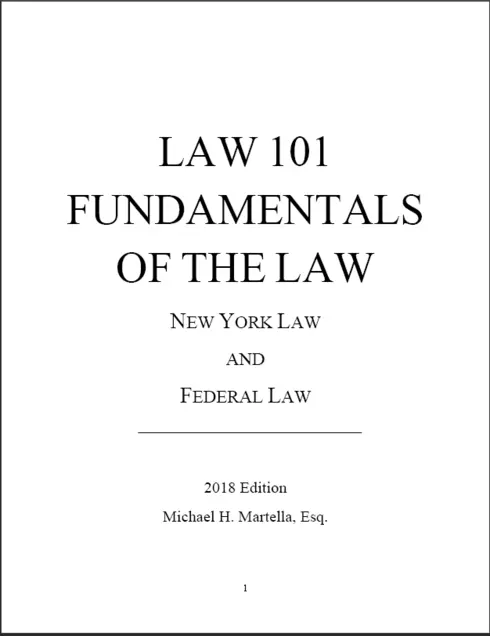
Law 101: Fundamentals of the Law
![]()
![]()
![]()
![]()
![]()
Michael H. Martella
Copyright Year:
Publisher: Open SUNY
Language: English
Formats Available
Conditions of Use
![]() Attribution
Attribution
CC BY
Reviews
Reviewed by Marcus Ellison, Adjunct Faculty, Trine University on 4/22/21
The textbook covers a wide variety of general legal areas. Each chapter can stand alone however, some are focused more on the nuances of New York state law and would best be suited for courses that require that. Other chapters however only cover... read more
![]()
![]()
![]()
![]()
![]()
Reviewed by Marcus Ellison, Adjunct Faculty, Trine University on 4/22/21
Comprehensiveness
The textbook covers a wide variety of general legal areas. Each chapter can stand alone however, some are focused more on the nuances of New York state law and would best be suited for courses that require that. Other chapters however only cover general legal principles or broad federal and constitutional law areas. It is worth the time to browse the table of contents as there are several stand-alone chapters that would work in a variety of legal subject matter area courses. There are also numerous citations and references throughout the textbook.
Content Accuracy
The text is accurate in its assertions and materials shared as of the time it is written. Each chapter has in-text citations and a list of references at the end of the chapter that supports the information that is cited and referred to throughout the text.
Relevance/Longevity
The content varies in that some of it covers specific areas and sections of the law that may need to be updated or refreshed frequently. However, other chapters cover broad-based legal principles and historical legal traditions that are timeless. Each chapter is independent of other chapters so it would be easy to use parts of this book for a wide variety of legal courses depending upon need.
Clarity
This book is written at a level that would be suitable for undergraduate students seeking a basic understanding of the American legal system or anyone wanting a basic understanding of how the law works. Some chapters have very practical steps that cover basics such as finding legal counsel and how cases progress through the legal system. The text is plain-spoken about most legal topics and not full of jargon and overly technical terminology.
Consistency
The book is consistent in terms of terminology and framework. Each chapter can be used and read as a stand-alone unit separate from the other chapters in the text.
Modularity
Each chapter of the book covers a unique area that can be studied separately from the other chapters. There are citations, references, and appropriate appendices again broken up by each chapter.
Organization/Structure/Flow
The book as a whole has a logical flow even though each chapter covers a unique area of law. Some chapters focus on legal specifics, in particular the sections that are heavy on New York State-specific law. Other sections are much more broad-based in focus and or cover more practical and background-oriented aspects of the law.
Interface
The text is laid out well with an appropriate amount of white space. The tables, charts, and visual cues are appropriate to the subject material.
Grammatical Errors
The text is free from grammatical and spelling errors.
Cultural Relevance
The textbook is not insensitive or offensive in any way and it has a chapter that focuses on discrimination law that is well-written, timely, and appropriate for the age and time.
CommentsThis is a good textbook for undergraduate students seeking a basic understanding of the law or for any student or person considering pursing a career in the legal field as an attorney or as a paralegal. The textbook is written in such a fashion that each chapter stands alone and thus its is a book that can be used in whole or in part as a reading resource for a legal class that covers almost any topical area of interest.
Table of Contents
- Chapter 1 – Major Factors In Choosing And Working With An Attorney
- Chapter 2 – Comparing And Contrasting Civil And Criminal Law
- Chapter 3 – New York State And Federal Court Structure And Sources Of Law
- Chapter 4 – How The United States And New York State Constitutions Affects Our Lives
- Chapter 5 – The Path Of A New York State Criminal Case
- Chapter 6 – Traffic Stops & DWI
- Chapter 7 – Discrimination Law
- Chapter 8 – The Path Of A Civil Tort Case
- Chapter 9 – Marriage, Divorce And Family Law
- Chapter 10 – Common Estate Planning Processes And Documents
- Chapter 11 – Taxes
- Chapter 12 – Real Estate Transfers
- Chapter 13 – Residential Lease Transactions
- Chapter 14 – Elements Of A Contract, Consumer Protections, And Bankruptcy
- Chapter 15 – Privacy
About the Book
Law 101: Fundamentals of Law, New York and Federal Law is an attempt to provide basic legal concepts of the law to undergraduates in easily understood plain English. Each chapter covers a different area of the law. Areas of law were selected based on what legal matters undergraduates may typically encounter in their daily lives. The textbook is introductory by nature and not meant as a legal treatise.Facebook
About the Contributors
Author
Michael H. Martella is an Assistant Professor at Monroe Community College in Rochester, New York. He is also the Director of the college’s ABA Approved Paralegal Studies Program. He has taught CRJ 101, Constitutional Law, Law 101, Domestic Relations, Introduction to Paralegal Studies, and Trusts and Estates. He has been a practicing attorney in the state of New York since 1982.
